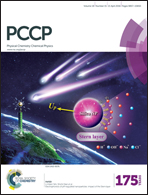Effects of substituent branching and chirality on the physical properties of ionic liquids based on cationic ruthenium sandwich complexes†
Abstract
An appropriate understanding of how substituents affect the physical properties of ionic liquids is important for the molecular design of ionic liquids. Toward this end, we investigated how the branching and chirality of substituents affect the physical properties of organometallic ionic liquids. We synthesized a series of ionic liquids bearing a branched or linear alkoxy group with the same number of carbons: [Ru(C5H5)(η6-C6H5OR)]X (rac-[1]X: R = –CH(C2H5)(C6H13), [2]X: R = –CH(C4H9)2, [3]X: R = –C9H19), where X = PF6−, (SO2F)2N−, and (SO2CF3)2N−. rac-[1]X are racemic salts. Salts with less symmetrical substituents tend to maintain the liquid state due to suppression of crystallization; crystallization is completely suppressed in most of the rac-[1]X salts and in some of the [2]X salts, whereas not in [3]X salts. The glass-transition temperatures and viscosities of the salts with branched substituents are greater than those with linear substituents. Chiral resolution of rac-[1][PF6] was performed by chiral chromatography. The melting point of rac-[1][PF6] is much lower than that of the enantiopure salt (chiral-[1][PF6]), which we ascribe to the formation of a conglomerate in the solid state. X-ray structure analysis revealed that the solid salts form layered structures.


 Please wait while we load your content...
Please wait while we load your content...